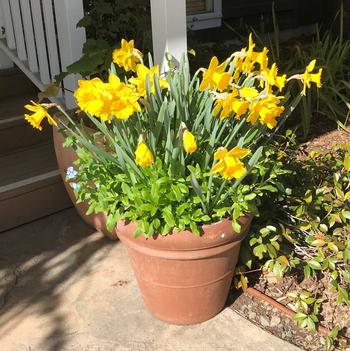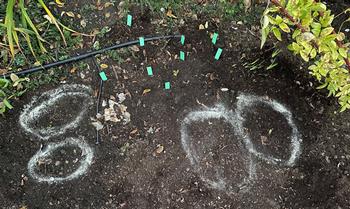Caring for spring bulbs
-
Jane Scurich
-
Is a “host of golden daffodils” filling your spring garden? Or do you have an abundance of foliage but not so many flowers? Or perhaps the blooms are not quite as robust as in previous years. It may be time to consider giving your cherished bulbs a little extra care.
 After flowering, snip off the withered bloom, apply a complete fertilizer, and allow the foliage to die naturally. Divide bulbs every 3-5 years.
After flowering, snip off the withered bloom, apply a complete fertilizer, and allow the foliage to die naturally. Divide bulbs every 3-5 years.The beauty of bulbs - as well as corms, rhizomes, and tubers - is that once planted, they are basically carefree. Leaves and stems are waiting patiently inside their little brown packages until a bit of rain and winter chill signals their inner calendar that it’s show time. Most all are relatively pest-free, drought-tolerant, and deer and rodent resistant. Tulips are an exception, as gophers and deer regard these as candy. Tulips are the least likely bulbs to rebloom in our Mediterranean climate, as they need a good long chill to encourage them to flower.
But basically, being carefree doesn’t mean that they wouldn’t benefit from some care after they bloom. Sometimes, after a few happy, vigorous years in the garden, you may notice a decline in your bulb activity. Following are a few suggestions to help invigorate your bulbs.
Once your flowers have faded, cut the spent bloom. This will eliminate the possibility of the flower head going to seed, further depleting the bulb’s energy. For next year’s blooms, it’s vital that the leaves remain in place until they have gathered as much sunlight as possible. The bulbs require these leaves to manufacture carbohydrates and store energy for the next year, through photosynthesis. This process may take six to eight weeks, depending on the weather. Allow the dead leaves to decompose in place or remove the foliage when it is yellowed, totally limp, and pulls away with no resistance. Do not be tempted to tie, braid, or rubber band the leaves. Consider overplanting with pansies or incorporate perennials in your bulb beds to camouflage the dying leaves. Heuchera, nepeta, and daylilies are excellent options.
It is important to apply a complete fertilizer (one that contains N-P-K: nitrogen, phosphorus, and potash) after bloom, spread the fertilizer around the base of the leaves, and continue minimal watering. Once leaves have withered, the bulbs can be dug up and stored in a dark, dry, cool place or simply left in the ground. Be careful not to overwater, as the bulbs may mildew or rot.
Crowded foliage and diminished flowering are signs that the bulb clumps need to be divided. Separating the bulbs every three to four years is a good idea, providing them with the needed space to encourage larger, healthy blooms. After the leaves die back, dig up the bulbs and carefully separate the offsets from the parents. Replant the bulbs immediately or store them in a cool, dry place until bulb-planting time in the fall. Plant the offsets twice as deep as their height; don't plant them as deep as mature bulbs. While smaller bulbs may not produce for a couple of years, larger bulbs will provide new flowers next season.
While your bulbs are blooming, take photos. Once the foliage dies back, you could easily dig right into a bulb during future planting! Your photos can also help you gauge whether your bulbs may be candidates for dividing. To prevent digging into your bulbs in the future, mark the planting areas with plant labels or outline them with bulb food, take a photo, and save.
To prevent digging into your bulbs in the future, mark the planting areas with plant labels or outline them with bulb food, take a photo, and save.Some of the best bulbs for naturalizing and repeat blooming in our local climate include daffodils, California native iris, muscari, scilla, and “species” tulips. For more information on selecting and planting bulbs and an extensive list of naturalizers, visit https://marinmg.ucanr.edu/ASK_US/THELEAFLET/?story=2318.
Year after year, with a little TLC, these little packages of stored energy will awaken with the warmer weather to help you welcome the return of spring!
Photo credits: Jane Scurich


